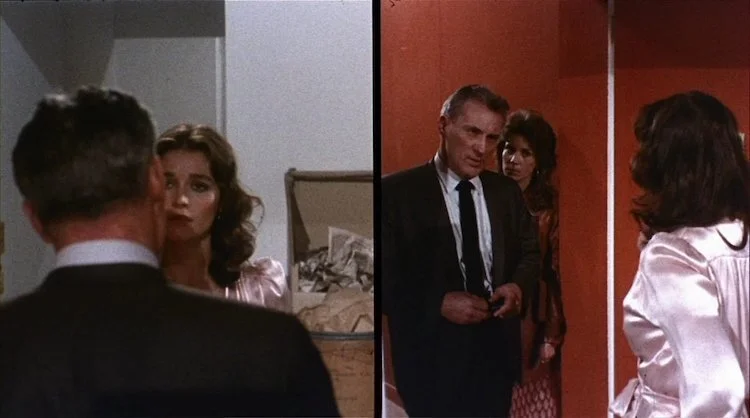SISTERS (1972)
If you spend any amount of time online, you’ve probably engaged in — or, at the very least, come across — conversations about the supposed politicization of popular media. Whether it be meddling right-wingers or snooty leftists, everyone seems to be under the impression that, for better or worse, genre films have evolved to reflect the increasing awareness of environmental issues, economic inequality, and race and gender politics that characterize our turbulent times. The horror genre in particular has become the target of much discussion between recent remakes of existing IP such as this year’s CANDYMAN and last year’s THE INVISIBLE MAN, the widespread acclaim of diverse new creators like Jordan Peele, and the wave of less successful knockoffs his films seem to be inspiring. Although many of these themes have certainly become increasingly overt in recent years, horror media has always been rife with blistering social critique, and the 1970s were proof of that. Brian De Palma’s psychosexual horror-thriller SISTERS is proof of that too.
Released in 1972, four years prior to his meteoric success with CARRIE, SISTERS remains a somewhat underrated gem in De Palma’s filmography, which also includes SCARFACE, BLOW OUT, PHANTOM OF THE PARADISE, and the first MISSION: IMPOSSIBLE among its many hits. Taking place in Staten Island, the movie follows a woman who attempts to investigate a murder case that goes ignored by the police. Suspecting her neighbor of the crime, she falls into a tangled web of dark secrets concerning said woman’s medical history and her caustic relationship to a mysterious twin.
There are several reasons De Palma’s fourth-most-popular horror scratches an itch few films can satisfy for me. For starters, its social implications feel as relevant as ever. Spoiling as little as possible, the man (Lisle Wilson) whose murder our protagonist Grace (Jennifer Salt) witnesses, is black. A hard-hitting journalist who’d previously written about corruption in the local police force, her claims are brushed aside by the detective who does not make an attempt to properly search the neighbor’s apartment for a body. He constantly belittles Grace and threatens to have her arrested for petty charges if she doesn’t lay off. The man’s race is brought up many times over the course of the film, with Grace implying that the police are racist for not taking the murder seriously and instead siding with the white woman (Margot Kidder) she accused of deadly assault.
Unbeknownst to the other characters, said white woman, Danielle, suffers from an undisclosed psychiatric illness, and lives under the medical and emotional care of her controlling husband, Emil (William Finley). Like in Alfred Hitchcock’s PSYCHO, the initial murder victim is followed closely during the film’s first act, which establishes him as a decent man unfazed by the microaggressions he undergoes in his day-to-day life until he is brutally killed off. As the story progresses, it becomes clear that the characters are being failed by what the film portrays as oppressive social and structural forces meant to protect them — resulting in a domino effect with catastrophic consequences.
SISTERS is also just a treat for movie and history buffs. As a big Hitchcock junkie, there are few things I love more than a good modern retelling of his work, from MANHATTAN MURDER MYSTERY (1993) to STOKER (2013). SISTERS is unique in that it pays homage to the revolutionary narrative and audiovisual techniques from the Master of Suspense’s entire career through obvious references to scenes from his most iconic films.
Himself equally fascinated by voyeurism, De Palma crafted the first two acts of SISTERS as what can only be described as a pastiche of PSYCHO, REAR WINDOW, and ROPE. And although the movie’s third act spirals into something totally perverse through a harrowing reveal montage that oozes De Palma’s unique visual style, its themes of abuse through psychosis and gaslighting feel reminiscent of VERTIGO as well. Frequent Hitchcock composer Bernard Herrmann even scores the film.
That’s not to say that this doesn’t feel like a Brian De Palma movie through and through. For me, each subsequent viewing of SISTERS has further cemented it as the craziest and most creative showcase of its director’s lauded visual style. Anyone who fell in love with CARRIE because of its novel use of split screens will be pleased to know that SISTERS is full of them. Its canted angles and unusual compositions form part of the director’s repertoire too.
And although I previously likened this film to ROPE, thanks in part to the latter’s famous long takes and tracking shots, I’d say De Palma employs these techniques even more effectively in SISTERS. A sequence where folks are stalling during the police search in Danielle’s apartment is a bigger nail-biter than anything in ROPE.
SISTERS also sports an excellent cast led by Kidder, whose delightfully hammy French-Canadian impression only adds to the movie’s creepy stiltedness. Finley is all too convincing as what I can only describe as one of the most nauseating horror villains of all time. Salt’s grounded and leveled performance as the inquisitive reporter makes you wonder why she never took off after this film. A colorful cast of supporting characters also give the film personality, and contribute to some great scares in the third act, which is one for the ages.
Few films are this deeply, perversely fun.
SISTERS is available for rent/purchase on Amazon Prime, on Criterion Blu-ray, rent/purchase via Apple, streaming on the Criterion Channel, and streaming on HBO Max.






